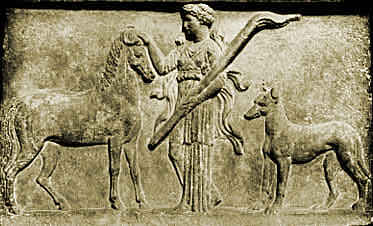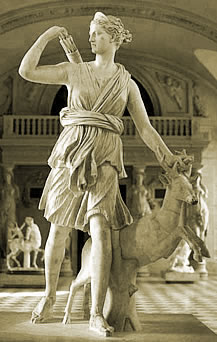

The goddess Artemis, whose brother is Apollo, is the daughter of Zeus and Leto. She is known as the goddess who overlooks hunting, wild animals and childbirth, because Artemis helped her mother, Leto, with the birth of her brother Apollo. She also is the protector of young girls until they are ready to marry. Artemis is one of the few gods and goddesses who remains a virgin. Artemisí wrath is the worst part of her. While she is the protector of young girls and wild animals, her wrath often included some children and animals to die; animals because of her being the goddess of the hunt, and children to avenge her mother, or for a sacrifice.
"Artemis was the great Olympian goddess of hunting, wilderness and wild animals. She was also a goddess of childbirth and the protectress of the girl child up to the age of marriage" (Atsma, Aaron).
Contradictory to her position as a protectress of young girls, she had ordered Agamemnonís youngest daughter, Iphigeneia, to be sacrificed after Agamemnon killed a stag and boasted that even Artemis could not have done a better job.
"When the expedition [for Troy] had mustered a second time at Aulis, Agamemnon, while at the chase, shot a stag and boasted that he surpassed even Artemis. At this the goddess was so angry that she sent stormy winds and prevented them from sailing. Kalkhas then told them of the anger of the goddess and bade them sacrifice Iphigeneia to Artemis. This they attempt to do, sending to fetch Iphigeneia as though for marriage with Akhilleus. Artemis, however, snatched her away and transported her to the Tauroi, making her immortal, and put a stag in place of the girl upon the altar." - Homerica, The Cypria Frag 1 (from Proclus Chrestomathy 1)" (Atsma).
Along with the sacrifice of Iphigeneia, Artemis was also guilty of killing many other children, including the Queen of Thebes, Niobeís fourteen children.
"Niobe, queen of Thebes, boasted that she was more worthy of worship than Leto, mother of Artemis and Apollo, because Leto had only two children but she, Niobe, had fourteen. Apollo and Artemis kill all Niobeís children" (Vandiver, Elizabeth. 37).
The story of Callisto is also an unfortunate one for Artemis. Artemis punished Callisto, who swore to remain a maid, when she was seduced by Zeus. When Callisto was pregnant and Artemis asked her about it, she told the goddess it was her fault. Artemis got angry and turned her into a bear (Parada).
Artemisí role in being the protector of children is contradictory according to these incidents.
Artemisí virginity and staying a maid is taken very seriously. She was one of the three goddesses that remained a virgin, the other two being Athene and Hestia.
"Artemis remained a maid, and those who have neglected this fact have been severely punished" (Parada, Carlos).
Take, for example, the story of Actaeon. Actaeon unintentionally saw Artemis and her nymphs bathing naked in a lake while he was hunting. Artemis, finding out about this, turns him into a deer, but keeps his mind human. Actaeon, aware of what was happening to him, ran away only to have his hunting hounds catch his scent and tear him to shreds (Vandiver, 38).
The story of Sipriotes, a young boy who saw the goddess bathing; Artemis turned him into a girl (Atsma).
"Being associated with chastity, Artemis at an early age (in one legend she was three years old) asked her father, the great god Zeus, to grant her eternal virginity. Also, all her companions were virgins. Artemis was very protective of her purity, and gave grave punishment to any man who attempted to dishonor her in any form" (Leadbetter, Ron).

The sinister part of Artemis comes out often, and when it does, the punishment tends to be very serious. The only account is the one of Iphigeneia, when Artemis replaced her with a stag on the altar. She is also known to bring plague and death with her arrows (Vandiver) that were made by Hephaestus and the Cylopes (Leadbetter).
All of her wraths include the use of her arrows.
For example, "An Arkadian man, of Southern Greece, who induced his people to expel the pregnant goddess Leto when she came to the land seeking refuge. The gods Apollo and Artemis later appeared, seeking to avenge their mother, and Leimos slew his brother out of fear of accusation. Artemis saw his guilt, and in her wrath, struck him down with arrows" (Atsma).
There is also an account of a large snake that followed Leto during her pregnancy, and when Artemis and Apollo were born, they slew the large serpent with their arrows (Atsma). Also, the giant Phokis, who tried to rape Leto while she was passing through a region in Central Greece. Artemis and Apollo rushed to rescue their mother, killing the giant with their arrows, and then sending Phokis down to Hades for the offense (Atsma).
She also had a strong defense when it came to virginity.
"Twin Giants, the Aloadai, from Thessalia, in Northern Greece, who attempted to storm heaven and seize the goddesses Hera and Artemis for their wives. Artemis assumed the form of a deer and rushed between them, tricking them into casting their spears, missing, and killing each other instead" (Atsma). The story of Bouphagos, whose attempt to rape the goddess ended with her killing him with her arrows.
The story of Artemis and Orion is not clear about which account really happened, but in the end of each story, she kills Orion, who was a great and fierce hunter, either by a scorpion or her arrows. Orion became a constellation in the sky, and is the astrological sign for Scorpio.

Artemis is also linked with Selene, the goddess of the moon, and Hecate, the Keeper of the Crossroads, but there is no direct link of Artemis to these two other goddesses. Selene represents the sky, Artemis the Earth, and Hecate the Underworld, which might correlate with birth, life, and death; childbirth, young girls, and hunting.
Works Cited
Atsma, Aaron. 2007. <http://theoi.com/Olympios/Artemis.html>
Vandiver, Elizabeth. Lecture 9. The Teaching Company. 2000.
Parada, Carlos. 1997. <http://homepage.mac.com/cparada/GML/Artemis.html>
"Artemis." Encyclopedia Mythica from Encyclopedia Mythica Online. <http://www.pantheon.org/articles/a/artemis.html>